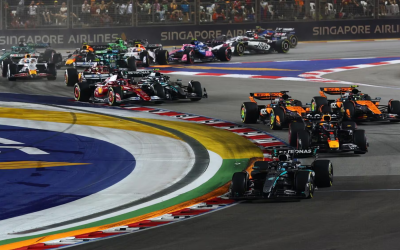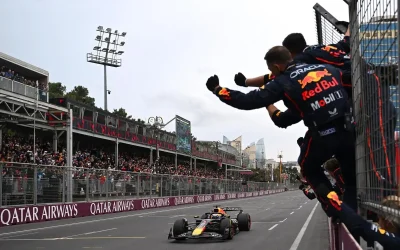An Australian GP full of unpredictability, marked by questionable choices by the FIA to bring out three red flags, was not enough to stop Verstappen and his unbeatable Red Bull.
The Dutchman ended the taboo – both for him and Red Bull – at Albert Park, never victorious and often unlucky on this track. The world champion, after losing first place at the start to Russell and Hamilton, was dominant in Melbourne.
Red Bull’s domination in Australia was not as severe as in the first two rounds of the 2023 season, even if the gap shown on the pursuers was always conspicuous.
Mercedes and Ferrari have certainly taken steps. However, Perez aside, Verstappen and Red Bull did not show their full potential in the race due to several factors.

No Red Bull approachable in Australia: without Perez, Max Verstappen played with his opponents
Were Red Bull more “humane” in Australia? As mentioned, Red Bull didn’t have as wide a gap from their rivals compared to the first two races. The reference to understanding the pace of the RB19 is always Verstappen, especially given Sergio Perez’s difficult weekend.
The Mexican seems to confirm last season’s trend, where, barring a few exploits, he doesn’t keep up with the performance of his Dutch teammate.
Max Verstappen could have certainly driven faster if there was pressure for the race win, as he did in Jeddah.
Perez eventually earned a fifth place that smacks of disappointment even though he started from the back. Three race suspensions weren’t enough to bring this RB19 to the podium, while in Jeddah, teammate Max had had a more marked and decisive comeback.

The Mexican driver had to fight most of the weekend with his RB19, especially under braking and a balance that gave him problems with the rear axle. Much of the Australian race was conditioned by a single target: bringing the car home with just one pit stop by managing the tyres.
Max Verstappen managed most of his race and his pace without stressing the tyres. Approach much appreciated by CEO Helmut Marko: “He did very well. At first, I was a little cautious, not very aggressive. He kept some distance from Hamilton and Russell to avoid contact. He knew he had a lot to lose. He was calm and then and hit at the right moment.”
This showcasing of the Dutchman’s race management is visible when he immediately went to take back the fast lap as soon as it was taken away from him by some other driver. Red Bull’s pace was not one second per lap compared to the first of the competitors.
However, Verstappen had a margin in the race pace of quite a few tenths also due to a mapping of the hybrid in the race deliberately kept lower in most parts of the race.
The secret of Adrian Newey’s car is having a large operating window
The graining suffered on these Pirelli tyres, especially during practice, put Red Bull at a crossroads on the set-up strategy to adopt. Max aligned himself with the more intense solution mounted since FP1 on his partner Checo’s RB19. Race-oriented set-up choice to reward tire life and traction.
This is quite unusual, given the trend that has always been at Red Bull, especially in 2022, where it was always Perez who adapted to Max’s solutions.
The world champion driver adapted to the more charged car without too many hitches, and in the moment of need, he pulled out all the stops in the last attempt of Q3 after the sudden step made by Mercedes.“We changed a lot of things in the car in terms of engine, balance, brakes and chassis compared to qualifying on Saturday, and things have gone much better.” – Sergio Perez said, going into the merits of the setup choices.
The first updates on the RB19 arrived in Australia, with a new front wing that offered greater downforce thanks to the last two flaps increased in the chord. The rear wing, on the other hand, was the same one used in Bahrain for the race, while in free practice, Max had used a lighter version in the main profile seen in Jeddah.

It is no coincidence that the heavier front wing was coupled to an equally heavier rear wing in order not to create problems of imbalance in the aerodynamic set-up between the two vehicle axles on a circuit that was clearly front-limited.
The beam wing was also different on the two machines, where the single profile beam wing was coupled to the heavier solution. Verstappen had ridden the bi-plane version in free practice, also adapting on this front to the single-element choice of teammate Checo.
The heavier solution has certainly benefited the tyres and their operating window, with the Milton Keynes team being one of the few to do just one launch lap to bring the tires into the window.
Furthermore, as the Melbourne track has four DRS zones, the decision to go for the more loaded solution was not so penalising in qualifying.

Still super-DRS in Australia: four DRS zones earned the RB19 almost 1 second
The RB19 is a car that goes strong both straight and cornering. A complete car that has few ‘cons’ in its concept compromises. One of these is a slower front ignition, mainly due to very anti-dive and anti-squat mechanics, designed to keep the aerodynamic platform as stable as possible.
The low ambient temperatures and low-energy asphalt certainly didn’t help:
“We can see that there are cars that fire their tires faster in qualifying but then pay off in terms of pace on Sunday. We have a compromise that favours the race over qualifying,” said Christian Horner.

What continues to frighten the new Anglo-Austrian car is the ability to generate load (aerodynamic and mechanical) with so little resistance to progress. In short, this is the goal of all technicians in F1.
It was almost embarrassing to see Verstappen’s RB19 stripping Hamilton’s Mercedes W14 of paint before turn 9-10, with a difference of no less than 36 km/h. It is also thanks to the combination with the made-in-Honda hybrid that the advantage that has been seen on practically every track for a year now is generated.
If in a track, then put four DRS zones, the game for Red Bull is done. On average, the delta time between a lap with DRS closed and one with DRS open on average earned Red Bull about a second. Mercedes and Ferrari have taken a step compared to 2022 on this front (Ferrari right away, Mercedes with the new rear wing), but Red Bull still maintains a certain margin.
On average, the lead in the four DRS zones can be estimated at 0.35 seconds on the main straight, 0.15, 0.5 and 0.2 seconds in the order in the other three zones.
In the first three races, the data show that the DRS gives the RB19 a percentage advantage in the DRS zones of 10% on the lap time, while Ferrari and Mercedes do not go beyond 8.5%.

The aerodynamic stall of the rear is something that the other teams are studying, including Ferrari, even if such an important gap is never due to a single technical characteristic. The big question is: Can Red Bull win them all?
This is the impression that insiders and others have, even if clearly the Anglo-Austrian team has every interest in showing a certain closeness to the competition, at least in the appointments where it can afford it (for various factors).
Something very negative for Liberty Media and the FIA, who with the advent of the ’22 rules, wanted a hard-fought F1 and instead will most likely find themselves seeing a 2023 championship already assigned with many races to go.
Of course, twenty-three races are still a good number, and the feat of winning them all remains quite utopian for now. However, there is no doubt that the RB19 has all the credentials to do better than 2022 to break further records in F1.
Author: Rosario Giuliana
Co-Author: Andrea Vergani
Translation: Jaden Diaz-Ndisang




